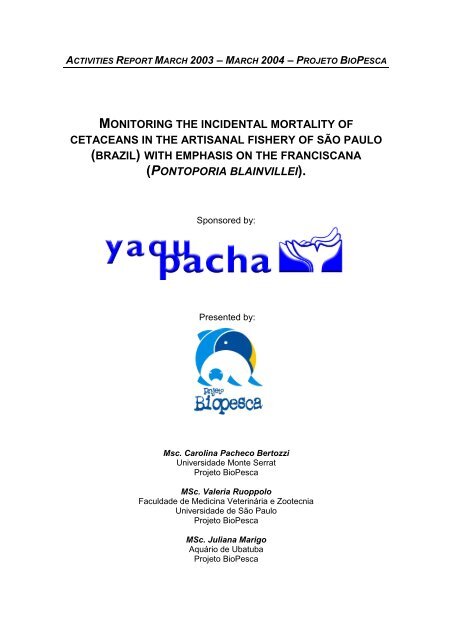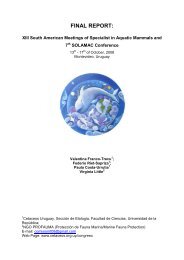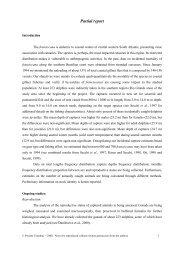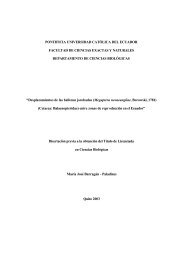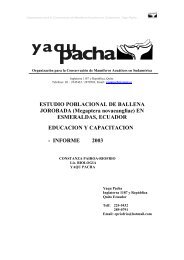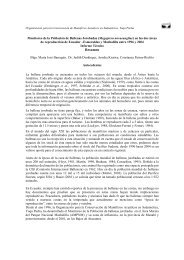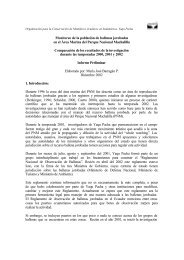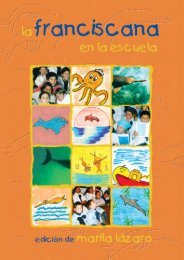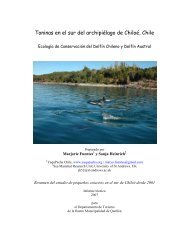monitoring the incidental mortality of cetaceans - Yaqu Pacha
monitoring the incidental mortality of cetaceans - Yaqu Pacha
monitoring the incidental mortality of cetaceans - Yaqu Pacha
Create successful ePaper yourself
Turn your PDF publications into a flip-book with our unique Google optimized e-Paper software.
ACTIVITIES REPORT MARCH 2003 – MARCH 2004 – PROJETO BIOPESCA<br />
MONITORING THE INCIDENTAL MORTALITY OF<br />
CETACEANS IN THE ARTISANAL FISHERY OF SÃO PAULO<br />
(BRAZIL) WITH EMPHASIS ON THE FRANCISCANA<br />
(PONTOPORIA BLAINVILLEI).<br />
Sponsored by:<br />
Presented by:<br />
Msc. Carolina Pacheco Bertozzi<br />
Universidade Monte Serrat<br />
Projeto BioPesca<br />
MSc. Valeria Ruoppolo<br />
Faculdade de Medicina Veterinária e Zootecnia<br />
Universidade de São Paulo<br />
Projeto BioPesca<br />
MSc. Juliana Marigo<br />
Aquário de Ubatuba<br />
Projeto BioPesca
Praia Grande, SP, Brazil<br />
March 2004<br />
1. INTRODUCTION AND BACKGROUND<br />
Mortality in fishing gear is possibly <strong>the</strong> most important threat to <strong>the</strong> conservation<br />
<strong>of</strong> marine vertebrate populations throughout <strong>the</strong> world (e.g. IWC, 1994). In Brazil,<br />
marine mammals are legally protected and are <strong>of</strong> no commercial value. Still, several<br />
species are <strong>incidental</strong>ly captured in fishing activities (e.g. Pinedo, 1994; Siciliano, 1994;<br />
Secchi et al., 1997; Zerbini and Kotas, 1998). Many are listed as ‘vulnerable’ or<br />
‘endangered’ by national and international organizations such as <strong>the</strong> Brazilian<br />
Environmental Agency (IBAMA), <strong>the</strong> US National Marine Fisheries Service (NMFS) and<br />
<strong>the</strong> World Conservation Union (IUCN).<br />
The NGO Projeto BioPesca has been developing research and environmental<br />
education activities since 1998. Its main objective is <strong>the</strong> conservation <strong>of</strong> <strong>the</strong> marine<br />
fauna, with emphasis on <strong>the</strong> <strong>incidental</strong> capture <strong>of</strong> <strong>cetaceans</strong> and marine turtles in <strong>the</strong><br />
artisanal fisheries on <strong>the</strong> São Paulo coast.<br />
This report summarizes <strong>the</strong> studies conducted along <strong>the</strong> past 5 years, in three<br />
main areas: Praia Grande, Mongaguá and Ubatuba.<br />
2. SIGNIFICANCE OF THE PROJECT<br />
This project represents <strong>the</strong> first long term <strong>monitoring</strong> <strong>of</strong> cetacean <strong>mortality</strong> in<br />
fishing gear in São Paulo State. The survey started with one landing location (Praia<br />
Grande - 6 fishing boats) (Bertozzi and Zerbini, 2002) and expanded to different fishing<br />
communities in Praia Grande (Bertozzi et al., 2003) and o<strong>the</strong>r areas (Mongaguá e<br />
Ubatuba), systematically <strong>monitoring</strong> a total <strong>of</strong> 20 boats utilizing artisanal fishing<br />
practices.<br />
Among <strong>the</strong> species <strong>incidental</strong>ly captured by <strong>the</strong> monitored artisanal fleet is <strong>the</strong><br />
franciscana (Pontoporia blainvillei), which is believed to be <strong>the</strong> most impacted cetacean<br />
<strong>of</strong>f <strong>the</strong> eastern coast <strong>of</strong> South America (e.g. Secchi et al., 1997), and is <strong>the</strong> only dolphin<br />
species listed to be in danger <strong>of</strong> extinction in Brazil (IBAMA, 2003). São Paulo State is<br />
part <strong>of</strong> <strong>the</strong> franciscana management area 2 (FMA2) (Secchi et al., 2001), which is <strong>the</strong><br />
less known among all franciscana management areas. Franciscanas’ by-catch has<br />
been observed along <strong>the</strong> coast <strong>of</strong> Sao Paulo State (SP) since early 1960’s (Carvalho,<br />
1961). Despite that, <strong>the</strong> characteristics and dynamics <strong>of</strong> <strong>the</strong> fishing fleet is poorly<br />
known, mainly because <strong>the</strong> communities are spread along <strong>the</strong> coast, some in areas<br />
with difficult access and <strong>the</strong>refore <strong>monitoring</strong> <strong>of</strong> those is <strong>of</strong> great importance for <strong>the</strong><br />
conservation <strong>of</strong> <strong>the</strong> species along its distribution.<br />
2
3. OBJECTIVES<br />
a) Monitor <strong>the</strong> <strong>incidental</strong> <strong>mortality</strong> <strong>of</strong> marine mammals in <strong>the</strong> artisanal<br />
fishery <strong>of</strong> Praia Grande and Mongaguá and strandings in Ubatuba;<br />
b) Characterize <strong>the</strong> fishing methods, and gear;<br />
c) Estimate franciscanas’ by-catch, season and areas <strong>of</strong> greater <strong>mortality</strong>;<br />
calculate catch per unit <strong>of</strong> effort (CPUE) <strong>of</strong> <strong>incidental</strong>ly captured species<br />
and monitor its trends over time;<br />
d) Collect samples for biological studies;<br />
e) Conduct divulging and environmental education campaigns with<br />
fishermen and <strong>the</strong> local community.<br />
4. SAMPLING METHODS<br />
a) Study area<br />
• Central coast <strong>of</strong> São Paulo State<br />
The fishing communities monitored are located in <strong>the</strong> cities <strong>of</strong> Praia Grande and<br />
Mongaguá, in <strong>the</strong> central coast <strong>of</strong> São Paulo State (Figure 1). This area is also known<br />
as “Baixada Santista”, and it is characterized by being highly urbanized, with highly<br />
populated areas, such as <strong>the</strong> cities <strong>of</strong> São Vicente, Santos and Cubatão. The area is<br />
also recognized by <strong>the</strong> most important Brazilian harbor, located in Santos, and by one<br />
<strong>of</strong> <strong>the</strong> biggest iron and steel industry areas <strong>of</strong> <strong>the</strong> country, <strong>the</strong> Cubatão pole (CETESB,<br />
1985).<br />
The region <strong>of</strong> Baixada Santista is one <strong>of</strong> <strong>the</strong> most productive marine ecosystems<br />
<strong>of</strong> <strong>the</strong> Brazilian coast. Despite <strong>the</strong> intense pollution, still is a zone <strong>of</strong> production and<br />
growth <strong>of</strong> many species <strong>of</strong> commercial interest (Secretaria de Agricultura e<br />
Abastecimento, 1989).<br />
• Nor<strong>the</strong>rn coast <strong>of</strong> São Paulo State<br />
The municipality <strong>of</strong> Ubatuba (~22 o 53’S, 45 o 08’W) (Figure 1) has a 100 km <strong>of</strong><br />
coast with 74 beaches. Differing from <strong>the</strong> central coast it does not have high<br />
populational densities, fact that is closely related to <strong>the</strong> proximity <strong>of</strong> <strong>the</strong> coastline to<br />
Serra do Mar, forming a narrow plain and limiting its occupation. The main activities in<br />
<strong>the</strong> region are tourism and fisheries, being one <strong>of</strong> <strong>the</strong> most important fish producers for<br />
<strong>the</strong> State.<br />
3
(a)<br />
(b) (c)<br />
(d)<br />
Figure 1. Map: (a) São Paulo’s State coast; (b) Detail <strong>of</strong> Praia Grande’s region; (c)<br />
Detail <strong>of</strong> Ubatuba’s region; (d) Detail <strong>of</strong> Mongaguá’s area.<br />
4
) Fisheries <strong>monitoring</strong><br />
The fisheries are monitored regularly through interviews with fishermen and on-<br />
board observations. Information about <strong>the</strong> fishery is obtained according to <strong>the</strong><br />
recommendations <strong>of</strong> <strong>the</strong> International Whaling Commission Scientific Committee (IWC,<br />
1994 – Annex E). These include data on gear characteristics, effort, fishing operations,<br />
and composition <strong>of</strong> target and not target species in <strong>the</strong> captures. Onboard observations<br />
are carried out whenever possible.<br />
The fishing community <strong>of</strong> Praia Grande and Mongaguá has been monitored<br />
through interviews with local fishermen and on-board observers with <strong>the</strong> following main<br />
goals:<br />
1) Understanding <strong>the</strong> dynamics <strong>of</strong> <strong>the</strong> fishing fleet and collect data on <strong>the</strong><br />
fishing gear characteristics;<br />
2) Monitoring <strong>cetaceans</strong>’ <strong>incidental</strong> catches;<br />
3) Collecting biological data on both target and non-target species.<br />
c) Data analysis<br />
The total fishing effort data <strong>of</strong> each boat is added seasonally, annually and by<br />
area <strong>of</strong> fishery for each kind <strong>of</strong> net, providing us information on <strong>the</strong> amount <strong>of</strong> nets<br />
utilized by <strong>the</strong> artisanal fleet. The data is expressed by: km <strong>of</strong> net x hours <strong>of</strong> fishing.<br />
To <strong>the</strong> <strong>incidental</strong> capture data analysis we used <strong>the</strong> relative abundance index<br />
CPUE (capture per unit <strong>of</strong> effort). This index is calculated as a function <strong>of</strong> <strong>the</strong> size <strong>of</strong><br />
<strong>the</strong> net and <strong>the</strong> time it spends in <strong>the</strong> water by <strong>the</strong> total number <strong>of</strong> franciscanas net<br />
caught x hours <strong>of</strong> fishing. Which, in this study is expressed by: number <strong>of</strong> individuals<br />
captured x 1000/ net extension in km x hours <strong>of</strong> fishing.<br />
The CPUE is calculated for each season, kind <strong>of</strong> net and fishing area. This<br />
provides information on <strong>the</strong> season <strong>of</strong> higher relative abundance <strong>of</strong> <strong>the</strong> species in <strong>the</strong><br />
study area, higher impact net and higher abundance area for franciscanas,<br />
respectively.<br />
d) Animals<br />
Live captured <strong>cetaceans</strong> are released from <strong>the</strong> nets, while dead animals are<br />
landed for biological studies. They are measured and sampled according to Norris<br />
(1961) and Geraci & Lounsbury (1993). Necropsies, sample collection, storage and<br />
analyses are performed by a team <strong>of</strong> biologists and veterinarians in Faculdade de<br />
Medicina Veterinária e Zootecnia, at <strong>the</strong> Universidade de São Paulo (Figure 2).<br />
Samples are stored in <strong>the</strong> LAPCOM-Marine Mammal Tissue Bank (LAPCOM-MMTB)<br />
5
(Ruoppolo et al., 2002). The goal <strong>of</strong> <strong>the</strong> biological specimen banking system is to<br />
provide long-term storage <strong>of</strong> tissue samples, histological slides, pathogens and images<br />
originated from <strong>the</strong> material for current and future studies. This biological samples are<br />
already being used for a variety <strong>of</strong> studies including: age determination; reproduction;<br />
food habits; contaminants; genetics; osteology; pathology; parasites; anatomy and<br />
o<strong>the</strong>rs (see Results).<br />
Figure 2. Necropsy <strong>of</strong> different specimens <strong>of</strong> P. blainvillei <strong>incidental</strong>ly caught by <strong>the</strong><br />
artisanal fishery in Praia Grande, SP, Brasil.<br />
f) Environmental education and divulging work<br />
It is important to carry out environmental education and divulging work on several<br />
levels, ranging from <strong>the</strong> fishermen, <strong>the</strong>ir communities and <strong>the</strong> local population. One<br />
important stage in conservation efforts is community involvement; <strong>the</strong>refore a number<br />
<strong>of</strong> activities are being conduced:<br />
1. Continued: destined to <strong>the</strong> fishing communities. Divulging work focus on<br />
encouraging fishermen to interact with researchers by showing <strong>the</strong>m <strong>the</strong> importance <strong>of</strong><br />
<strong>the</strong>ir cooperation to improve <strong>the</strong> conservation <strong>of</strong> protected species. Daily contact <strong>of</strong><br />
researchers and fishermen communities allows <strong>the</strong>m to learn and participate effectively<br />
on <strong>the</strong> study, transforming <strong>the</strong>ir participation as co-executers. Newspapers, magazines,<br />
pictures and o<strong>the</strong>r project results are constantly presented to <strong>the</strong> fishermen to stimulate<br />
discussions about <strong>the</strong> subject and increase <strong>the</strong>ir knowledge and awareness about <strong>the</strong><br />
information <strong>the</strong>y provide.<br />
2. Exhibitions: destined to <strong>the</strong> general public. Environmental education<br />
campaigns bring to <strong>the</strong> general public's attention <strong>the</strong> natural world and its problems,<br />
aiming to develop values and feelings <strong>of</strong> concern for nature and <strong>the</strong> motivation for<br />
people's participation in environmental improvement and protection. Aiming to reach a<br />
larger number <strong>of</strong> people, exhibitions were set at areas <strong>of</strong> public interest, displaying<br />
6
pictures, franciscanas’ assembled skeletons, educational posters presenting <strong>the</strong> goals<br />
and results obtained by <strong>the</strong> project, talks about marine mammals and a small play for<br />
children, all about <strong>the</strong> importance <strong>of</strong> preserving <strong>the</strong> marine environment and its<br />
species.<br />
3. Talks: destined to students in schools and universities. Performed by Projeto<br />
BioPesca researchers aiming to introduce <strong>the</strong> project and its results, as well as to bring<br />
awareness about conservation <strong>of</strong> <strong>the</strong> marine environment.<br />
4. Media reports: during its work Projeto BioPesca was subject <strong>of</strong> many media<br />
reports on newspapers and TV showing <strong>the</strong> results <strong>of</strong> our work to <strong>the</strong> knowledge <strong>of</strong> a<br />
higher number <strong>of</strong> people.<br />
5. Webpage: in January 2004 Projeto BioPesca’s webpage was published:<br />
www.biopesca.oceanografia.org. It contains information on <strong>the</strong> research developed and<br />
educational texts on <strong>the</strong> threats for <strong>the</strong> marine environment.<br />
5. RESULTS AND DISCUSSION<br />
a) Monitoring <strong>of</strong> artisanal fishery <strong>of</strong> Praia Grande, SP, Brazil<br />
The Fisheries<br />
27 fishermen compose <strong>the</strong> fishing community <strong>of</strong> Praia Grande. They operate 11<br />
small fishing boats (4.2 to 7.8m long) equipped with outboard engines (18-40Hp) and 2<br />
‘Tamancas’ propelled by paddles by one <strong>of</strong> <strong>the</strong> fishermen (Figure 3). Five different<br />
types <strong>of</strong> gillnets and one beach seine net are used. The gillnets are ei<strong>the</strong>r set in <strong>the</strong><br />
bottom or left adrift for periods ranging from 1 to 22 hours. The fleet operates in coastal<br />
waters (depths <strong>of</strong> up to 20m) from Praia Grande to Mongaguá and Moela Island –<br />
Guarujá.<br />
7
Figure 3. “Tamanca” paddle propelled boat, Praia Grande, SP, Brasil.<br />
Franciscana by-catch<br />
The relative small size <strong>of</strong> <strong>the</strong> fleet operating in <strong>the</strong> area allowed all fishing boats<br />
to be monitored. Therefore <strong>the</strong> number <strong>of</strong> franciscana catches recorded in this study is<br />
considered absolute for <strong>the</strong> area and period <strong>the</strong> fishery was monitored.<br />
From August 1998 to June 2003 <strong>the</strong> local fishing community accidentally took a<br />
total <strong>of</strong> 51 franciscanas (Figura 4). Three franciscanas were captured in a beach seine<br />
net in November 1998 and were released alive. Such events are uncommon and were<br />
only observed once. Most animals are found dead.<br />
A total <strong>of</strong> 24 dolphins were landed by <strong>the</strong> fishermen, been 16 females (length =<br />
69-122cm) and 8 males (length=71-134cm). Females were mostly immature, while <strong>the</strong><br />
proportion <strong>of</strong> juvenile and mature males was equal.<br />
Figure 4. Franciscanas’ by-catch in artisanal nets, Praia Grande, SP, Brasil.<br />
8
CPUE Analysis<br />
Catch per unit <strong>of</strong> effort (CPUE) analysis was performed for a period <strong>of</strong> four years,<br />
during which 43 franciscanas were <strong>incidental</strong>ly captured. The CPUE analysis suggests<br />
that a greater <strong>mortality</strong> occur near Moela Island, in depths <strong>of</strong> up to 10m and may<br />
indicate that abundance is higher in this location. Captures occurs throughout <strong>the</strong> year<br />
and in all seasons but CPUE is higher in <strong>the</strong> fall and indicate that franciscanas are<br />
more vulnerable to net types ‘boeira’ and ‘fundo grossa’.<br />
(a) (b)<br />
(c)<br />
CPUE<br />
CPUE<br />
20<br />
15<br />
10<br />
5<br />
0<br />
Figure 5. CPUE: (a) Moela Island; (b) Up to 10m and (c) 10-20m<br />
Conclusion<br />
Moela Island<br />
Winter Spring Summer Fall<br />
Pescada Malhão Fundo Grossa Boeira Feiticeira<br />
0.20<br />
0.15<br />
0.10<br />
0.05<br />
0.00<br />
10-20m<br />
Winter Spring Summer Fall<br />
Pescada Malhão Fundo Grossa Boeira Feiticeira<br />
Up to 10m<br />
The annual <strong>mortality</strong> <strong>of</strong> franciscanas in Praia Grande seems to be low. However,<br />
Praia Grande is a small fishing community and <strong>the</strong>re are several small communities<br />
similar to this one distributed along <strong>the</strong> coast <strong>of</strong> SP. It is possible that <strong>the</strong> <strong>mortality</strong><br />
numbers may become important when summed for <strong>the</strong> different locations on <strong>the</strong> whole<br />
state. It is necessary to expand <strong>the</strong> systematical <strong>monitoring</strong> to o<strong>the</strong>r fishing<br />
communities to be able to evaluate <strong>the</strong> damage on <strong>the</strong> FMA2’s population.<br />
CPUE<br />
0.20<br />
0.15<br />
0.10<br />
0.05<br />
0.00<br />
9<br />
Winter Spring Summer Fall<br />
Pescada Malhão Fundo Grossa Boeira Feiticeira
) Monitoring <strong>the</strong> artisanal fishery in Mongaguá, SP, Brasil<br />
The Fishery<br />
The fishing activities in <strong>the</strong> municipality <strong>of</strong> Mongaguá are very similar when<br />
compared to Praia Grande’s fleet. Both communities use gillnets, small fishing boats<br />
equipped with outboard engines and also have o<strong>the</strong>r boats that don’t present any kind<br />
<strong>of</strong> mechanization or equipment on board. Due to <strong>the</strong> limited autonomy <strong>of</strong> <strong>the</strong> fleet <strong>the</strong><br />
fisheries are restricted within <strong>the</strong> 20m isobath.<br />
The fleet monitored in Mongaguá was composed by 2 wooden boats (Figure 6)<br />
with 7,6m length and powered by a 9 and 13 Hp centered motor. The nets utilized by<br />
<strong>the</strong>se boats were gillnets. Thee mesh size used ranged between 7 to 30 cm and <strong>the</strong><br />
time <strong>the</strong> nets were left in <strong>the</strong> water ranged from 2 to 24 hours.<br />
Figure 6. The fishing fleet monitored in Mongaguá, SP, Brasil.<br />
Franciscana’s by-catch<br />
During <strong>the</strong> period <strong>the</strong> by-catch <strong>of</strong> 4 franciscanas was recorded. Two were landed,<br />
necropsied and sampled. The nets involved were bottom nets (mesh 7cm) and surface<br />
nets (mesh 10cm). The area was below <strong>the</strong> 10m isobath.<br />
The stranding <strong>of</strong> a live calf was also recorded in Mongaguá. The animal was<br />
rescued but died soon after (Figure 7).<br />
10
Conclusion<br />
Figure 7. Live stranded franciscana’s calf.<br />
Besides <strong>the</strong> small number <strong>of</strong> fishing boats monitored <strong>the</strong> <strong>incidental</strong> catch <strong>of</strong><br />
franciscanas’ was confirmed in <strong>the</strong> area by artisanal fishermen.<br />
These results suggest that <strong>the</strong> number <strong>of</strong> animals caught may be substantial<br />
along this municipality due to <strong>the</strong> fact that similar boats are found in <strong>the</strong> area.<br />
c) Monitoring strandings in Ubatuba, SP, Brazil<br />
In December 1996 <strong>the</strong> institution “Aquário de Ubatuba” started <strong>monitoring</strong><br />
strandings. In July 1997 “Project Delphinus” was created and also monitored until May<br />
1998. During this period 15 strandings were recorded. Sotalia fluviatilis was <strong>the</strong> most<br />
common species recorded (73,3%, 11/15). Two Pontoporia blainvillei, one Delphinidae<br />
and one Balenopteridae were also recorded. Thirteen strandings (87%, 13/15) were<br />
recorded during summer months, when <strong>the</strong> number <strong>of</strong> people frequenting <strong>the</strong> area is<br />
larger and increases observation efforts (Higa et al., 1998).<br />
Since <strong>the</strong>n “Aquário de Ubatuba” has been responding to local calls for live and<br />
dead marine mammals. In 2002, Projeto BioPesca started getting more involved,<br />
helping with <strong>the</strong> rehabilitation <strong>of</strong> a franciscana calf and in 2003 one <strong>of</strong> our researchers<br />
has moved to Ubatuba to collect more data in collaboration with this institution.<br />
Between July 2000 and March 2004, 25 records <strong>of</strong> marine mammals occurred.<br />
Pontoporia blainvillei and Sotalia fluviatilis were <strong>the</strong> most common species (28%, 7/25<br />
and 24%, 6/25 respectively) (Figure 8).<br />
11
(a) (b)<br />
Figure 8. Strandings: (a) stranded franciscana; (b) researcher collecting data.<br />
d) Environmental education and divulging work<br />
As described in methods, <strong>the</strong> divulging work was conducted in different ways:<br />
constant contact with <strong>the</strong> fishermen communities and exhibitions in public locations.<br />
1. Continued: The educational work with <strong>the</strong> fishery communities was performed<br />
by <strong>the</strong> researchers during frequent interviews. Copies <strong>of</strong> <strong>the</strong> research permits were<br />
handed to <strong>the</strong> fishermen encouraging <strong>the</strong>m to collaborate with information and<br />
specimens without <strong>the</strong> fear <strong>of</strong> been punished by law enforcement. Information about<br />
<strong>the</strong> project and marine animals were constantly presented to <strong>the</strong>m aiming to bring<br />
information <strong>of</strong> <strong>the</strong>ir interest. In addition, posters are being fixed at <strong>the</strong> landing spots to<br />
inform locals about <strong>the</strong> project goals and conservation efforts.<br />
2. Exhibitions: Environmental educational campaigns to inform <strong>the</strong> general public<br />
about <strong>the</strong> project:<br />
2.1 Universidade Monte Serrat, Santos, SP, Brazil: consisted <strong>of</strong> a big exhibition<br />
showing educational posters, research results and information on <strong>the</strong> main species<br />
captured by <strong>the</strong> fishery communities (franciscanas and sea turtles). Graduation<br />
students from <strong>the</strong> Oceanography faculty were trained to act as monitors during <strong>the</strong><br />
exhibition. The exhibition lasted for (January 27 th to February 2 nd 2003?) and was<br />
visited by more than 1458 people, who are <strong>the</strong> ones who signed <strong>the</strong> guest book (see<br />
pictures sent by mail). The exhibition was published by local newspapers.<br />
12
2.2. “Shopping Boqueirão”. In February 2004 <strong>the</strong> Projeto BioPesca exhibition II<br />
was set at Shopping Center Boqueirão (a shopping center located at Praia Grande’s<br />
main street). This year’s exhibition had educational posters presenting <strong>the</strong> results<br />
obtained and information on <strong>the</strong> main species captured by <strong>the</strong> fishery communities<br />
(franciscanas and sea turtles); picture panels, franciscanas’ assembled skeletons and<br />
a formalin fixed fetus; o<strong>the</strong>r marine species, fishing gear, natural sized franciscanas<br />
and marine turtles made <strong>of</strong> wood, and a magnifier for observation <strong>of</strong> zooplankton<br />
(Figure 9). To make <strong>the</strong> exhibition more dynamic <strong>the</strong>re were daily talks about marine<br />
animals, a play for children and an origami workshop.<br />
(c) (d)<br />
13<br />
(a) (<br />
Figure 9. II Projeto BioPesca Exhibition: (a) & (b) general view <strong>of</strong> <strong>the</strong> exhibition; (c)<br />
supervisor showing biological material to <strong>the</strong> public; (d) detail <strong>of</strong> <strong>the</strong> wooden built<br />
models <strong>of</strong> franciscana.<br />
b)
The puppets play was entitled “The deep sea” and lasted 15 minutes, played<br />
several times a day. It presented <strong>the</strong> <strong>incidental</strong> capture threat and <strong>the</strong> importance <strong>of</strong><br />
<strong>the</strong> pollution <strong>of</strong> <strong>the</strong> beaches in a ludic way (Figure 10). Videos were exhibit during all<br />
day and a children area was set where kids could paint marine animal pictures.<br />
Members <strong>of</strong> <strong>the</strong> project were available for questions and mini lectures (Figure 11).<br />
(a) (b)<br />
(c)<br />
Figure 10. Puppets play “The deep sea”: (a) scenary; (b) presentation; (c) BioPesca’s<br />
actors.<br />
T-shirts were given to <strong>the</strong> fishermen at <strong>the</strong> exhibition encouraging <strong>the</strong>m to attend<br />
and learn more about <strong>the</strong> project, <strong>the</strong> animals and <strong>the</strong>ir importance. The exhibition<br />
lasted for a week (February 2 –8, 2004) and was visited by at least 1458 people, which<br />
are <strong>the</strong> ones who signed <strong>the</strong> guest book (see pictures sent by mail). The exhibition was<br />
divulged by local newspapers, radio and TV (see newspapers sent by mail).<br />
14
(a) (b)<br />
Figure 11. Supervisors in action: (a) monitored visit to <strong>the</strong> exhibition; (b) daily talks on<br />
marine mammals were given.<br />
3. Talks: Researchers from <strong>the</strong> project have been invited to give talks in different<br />
schools, high schools, universities and o<strong>the</strong>r events related to <strong>the</strong> marine environment,<br />
for example: Universidade Santa Cecília, Santos, SP; CEESMAG, Praia Grande, SP<br />
and Aquário de Ubatuba, Ubatuba, SP.<br />
6. FUTURE :<br />
It is necessary to continue our divulging work with this and o<strong>the</strong>r fishing<br />
communities in order to clear <strong>the</strong> importance <strong>of</strong> <strong>the</strong>ir participation, becoming more<br />
involved and participating <strong>of</strong> <strong>the</strong> research team, ra<strong>the</strong>r than just being simple<br />
‘collectors’.<br />
The success <strong>of</strong> management and conservation actions <strong>of</strong> species threatened by<br />
by-catch depends on how well <strong>the</strong> biology <strong>of</strong> <strong>the</strong> species, <strong>the</strong> structure <strong>of</strong> <strong>the</strong> fisheries<br />
and its interaction is known.<br />
Therefore, <strong>the</strong> continuity and expansion <strong>of</strong> this <strong>monitoring</strong> study is extremely<br />
important for <strong>the</strong> evaluation <strong>of</strong> <strong>the</strong> impact <strong>of</strong> fisheries on franciscana’s population in<br />
São Paulo State and to propose appropriated actions <strong>of</strong> management for its<br />
conservation.<br />
15
6. PAPERS PRESENTED BY PROJETO BIOPESCA :<br />
a) Publications in Scientific Journals:<br />
Bertozzi, C. P. and Zerbini, A.N. 2002. Incidental <strong>mortality</strong> <strong>of</strong> franciscana,<br />
Pontoporia blainvillei, in <strong>the</strong> artisanal fishery <strong>of</strong> Praia Grande, São Paulo State, Brazil.<br />
Latin American Journal <strong>of</strong> Aquatic Mammals 1(1): 153-160.<br />
Danilewicz, D.; Rosas, F.; Bastida, R.; Marigo, J.; Muelbert, M.; Rodriguez, D.;<br />
Lailson-Brito Jr., J.; Ruoppolo, V.; Ramos, R.; Bassoi, M.; Ott, P.H.; Caon, G.; Rocha,<br />
A.M.; Catao-Dias, J.L. and Secchi, E.R. 2002. Report <strong>of</strong> <strong>the</strong> Working Group on Biology<br />
and Ecology (Report <strong>of</strong> <strong>the</strong> Fourth Workshop for <strong>the</strong> Coordinated Research and<br />
Conservation <strong>of</strong> <strong>the</strong> Franciscana. Latin American Journal <strong>of</strong> Aquatic Mammals 1 (1):25-<br />
42.<br />
Marigo, J., Rosas, F.C.W., Andrade, A.L.V., Oliveira, M.R., Dias, R.A. and<br />
Catão-Dias, J.L. 2002. Parasites <strong>of</strong> Pontoporia blainvillei from São Paulo and Paraná<br />
States, Brazil. Latin American Journal <strong>of</strong> Aquatic Mammals 1 (1):115-122.<br />
Ott, P. H.; Secchi, E. R.; Moreno, I. B.; Danilewicz, D.; Crespo, E. A.; Bordino, P.;<br />
Ramos, R.; Di Beneditto, A.P.; Bertozzi, C. P.; Bastida, R.; Zanelatto, R.; Perez, J. E.<br />
& Kinas, P. G. 2002. Report <strong>of</strong> <strong>the</strong> working group on fishery interactions. Latin<br />
American Journal <strong>of</strong> Aquatic Mammals 1(1): 55-64.<br />
Ramos, R. M. A.; Di Beneditto, A. P. M.; Siciliano S.; Santos, M. C. de Oliveira;<br />
Zerbini, A. N.; Bertozzi, C. P.; Vicente, A. F. de Castro; Zampirolli, E.; Alvarenga, F. S.<br />
& Lima, N. R. W. 2002. Morphology <strong>of</strong> <strong>the</strong> franciscana (Pontoporia blainvillei) <strong>of</strong>f<br />
sou<strong>the</strong>astern Brazil: sexual dimorphism, growth and geographic variation. Latin<br />
American Journal <strong>of</strong> Aquatic Mammals 1(1): 129-144.<br />
Rosas, F.C.W.; Monteiro-Filho, E.L.A.; Marigo, J.; Santos, R.A.; Andrade, A.L.V.;<br />
Rautenberg, M.; Oliveira, M.R. and Bordignon, M. O. 2002. The striped dolphin,<br />
Stenella coeruleoalba (Cetacea:Delphinidae), on <strong>the</strong> coast <strong>of</strong> São Paulo State,<br />
sou<strong>the</strong>astern Brazil. Aquatic Mammals 28(1): 60-66.<br />
Secchi, E.R.; Danilewicz, D.; Ott, P.H.; Ramos, R.; Lazaro, M.; Marigo, J. and<br />
Wang, J.Y. 2002. Report <strong>of</strong> <strong>the</strong> Working Group on Stock Identity (Report <strong>of</strong> <strong>the</strong> Fourth<br />
Workshop for <strong>the</strong> Coordinated Research and Conservation <strong>of</strong> <strong>the</strong> Franciscana). Latin<br />
American Journal <strong>of</strong> Aquatic Mammals 1 (1): 47-54.<br />
b) Abstracts presented at national and international conferences:<br />
Bertozzi, C. P.; Barbosa, E.; Marigo, J.; Ruoppolo, V.; Zerbini, A.N.: Incidental<br />
captures <strong>of</strong> franciscana, Pontoporia blainvillei, in <strong>the</strong> artisanal fishery <strong>of</strong> Praia Grande,<br />
16
Sou<strong>the</strong>astern Brazil. Proceedings 15 th Biennial Conference on <strong>the</strong> Biology <strong>of</strong> Marine<br />
Mammals. Greensboro, Noth Carolina, USA – 15-19 December 2003.<br />
Marigo, J.; Catão-Dias, J.L. Comparative pathology <strong>of</strong> <strong>the</strong> main parasitic<br />
diseases <strong>of</strong> marine mammals found in <strong>the</strong> south and sou<strong>the</strong>astern coasts <strong>of</strong> Brazil.<br />
Abstracts 15 th Biennial Conference on <strong>the</strong> Biology <strong>of</strong> Marine Mammals, 14-19<br />
December 2003.<br />
Bastos, L., B.; Marigo, J. Occurrence <strong>of</strong> pulmonary nematodes in <strong>cetaceans</strong><br />
stranded along <strong>the</strong> coast <strong>of</strong> Bahia state, Brazil. Abstracts 15 th Biennial Conference on<br />
<strong>the</strong> Biology <strong>of</strong> Marine Mammals, 14-19 December 2003.<br />
Bertozzi, C. P.; Katsuragawa, M. Análise preliminar da pesca artesanal na região<br />
da Praia Grande (SP), no período 1999-2001. Simpósio Brasileiro de Oceanografia.<br />
Instituto Oceanográfico USP - IOUSP, 26 - 30 August 2002.<br />
Bertozzi, C. P. Zerbini A. N.; Katsuragawa, M. Capturas acidentais de tartarugas<br />
marinhas pela frota pesqueira artesanal da Praia Grande (SP). Simpósio Brasileiro de<br />
Oceanografia. Instituto Oceanográfico USP - IOUSP, 26 - 30 August 2002.<br />
Bertozzi, C. P.; Zerbini A. N. Capturas acidentais de franciscana, Pontoporia<br />
blainvillei (CETACEA: PONTOPORIDAE), e avistagens de cetáceos em<br />
monitoramentos da pesca artesanal da Praia Grande, São Paulo. In: Resumos do 6 º<br />
Simpósio de Biologia da Unisanta, 2001, Santos, Brasil. p43.<br />
Bertozzi, C. P.; Zerbini A. N. Capturas acidentais de franciscana, Pontoporia<br />
blainvillei, na pesca artesanal de Praia Grande, São Paulo, Brasil. In: Resumos da 9 0<br />
Reunión de Trabajo de Especialistas en Mamíferos Acuáticos de América del Sur.<br />
2000, Buenos Aires, Argentina. p14.<br />
Bertozzi, C. P.; Namora R.; Gadig, O. B. Elasmobrânquios capturados pela<br />
pesca artesanal de Praia Grande, SP. In: Resumos 2 0 SBEEL, 2000, Santos, Brasil.<br />
p39.<br />
Marigo, J.; Rosas, F.C.W.; Andrade, A.L.V.; Oliveira, M.R.; Bertozzi, C.P.;<br />
Ruoppolo, V.; Dias, R.A.; Catão-Dias, J.L. (2002) Parasites <strong>of</strong> franciscana dolphins<br />
(Pontoporia blainvillei) from São Paulo and Paraná States, Brazil. Proceedings <strong>of</strong> <strong>the</strong><br />
Annual Meeting <strong>of</strong> <strong>the</strong> American Association <strong>of</strong> Zoo Veterinarians, p. 424-425.<br />
Wisconsin, U.S.A.<br />
Marigo, J.; Rosas, F.C.W.; Andrade, A.L.V.; Oliveira, M.R.; Bertozzi, C.P.;<br />
Ruoppolo, V.; Dias, R.A.; Catão-Dias, J.L. (2002) Parasites <strong>of</strong> franciscana dolphins<br />
(Pontoporia blainvillei) from São Paulo and Paraná States. XIII Semana Científica do<br />
Departamento de Patologia (FMVZ - USP), São Paulo, Brazil.<br />
Ruoppolo, V.; Marigo, J. e Catão-Dias, J.L. (2002) Creating a marine mammal<br />
tissue bank in Brazil. Proceedings <strong>of</strong> <strong>the</strong> 10 ma Reunión de Trabajos de Especialistas en<br />
17
Mamíferos Acuáticos de América del Sur e 4 o Congreso de La Sociedad<br />
Latinoamericana de Especialistas en Mamíferos Acuáticos, p.113, Valdivia, Chile.<br />
Ruoppolo, V.; Marigo, J.; Catão-Dias, J. L. (2002) Pathological anatomy and<br />
parasitology <strong>of</strong> Atlantic spotted dolphins, Stenella frontalis, <strong>incidental</strong>ly captured in<br />
fishing net in São Paulo. Proceedings <strong>of</strong> <strong>the</strong> 6th Congress and 11th Meeting <strong>of</strong> <strong>the</strong><br />
Brazilian Association <strong>of</strong> Wildlife Veterinarians (VI ABRAVAS), p. 71. Guarapari, Espírito<br />
Santo, Brazil.<br />
Souza, S. P.; De Sanctis, B.; Ruoppolo, V.; Catão-Dias, J. L. (2002) Occurrence<br />
<strong>of</strong> <strong>the</strong> dwarf sperm whale (Kogia sima) in <strong>the</strong> nor<strong>the</strong>rn coast <strong>of</strong> <strong>the</strong> State <strong>of</strong> São Paulo.<br />
Proceedings <strong>of</strong> <strong>the</strong> 10 ma Reunión de Trabajo de Especialistas en Mamíferos Marinos<br />
de América del Sur, p. 116. Valdívia, Chile.<br />
c) Master’s dissertations defended:<br />
Bertozzi, C. P. 2002. Analysis <strong>of</strong> <strong>the</strong> artisanal fisheries at Praia Grande, São<br />
Paulo, Brazil between 1999-2001. Master <strong>the</strong>sis presented at <strong>the</strong> Oceanographic<br />
Institute, Universidade de São Paulo.<br />
Ruoppolo, V. 2003. Comparative pathology <strong>of</strong> <strong>cetaceans</strong> and pinnipeds. Master<br />
<strong>the</strong>sis presented to <strong>the</strong> School <strong>of</strong> Veterinary Medicine, Universidade de São Paulo.<br />
Marigo, J. 2003. Comparative pathology <strong>of</strong> <strong>the</strong> main parasitic diseases <strong>of</strong> marine<br />
mammals found in <strong>the</strong> south and sou<strong>the</strong>astern coasts <strong>of</strong> Brazil. Master <strong>the</strong>sis<br />
presented to <strong>the</strong> School <strong>of</strong> Veterinary Medicine, Universidade de São Paulo<br />
d) In collaboration with Projeto BioPesca (provided samples):<br />
Yogui, G. 2001. Occurence <strong>of</strong> organochlorine compounds (Pesticides and PCBs)<br />
in marine mammals <strong>of</strong> <strong>the</strong> São Paulo coast (Brasil) and <strong>the</strong> King George Island<br />
(Antarctica). Master <strong>the</strong>sis presented at <strong>the</strong> Oceanographic Institute, Universidade de<br />
São Paulo.<br />
Higa, A.; Hingst-Zaher, E. and de Vivo, M. 2002. Size and shape variability in <strong>the</strong><br />
skull <strong>of</strong> Pontoporia blainvillei (Cetacea: Pontoporiidae) from <strong>the</strong> Brazilian Coast. Latin<br />
American Journal <strong>of</strong> Aquatic Mammals 1(1): 145-152.<br />
18
7. BUDGET<br />
Table 1 – Budget from <strong>the</strong> past research proposal.<br />
DIVULGATION MATERIAL<br />
19<br />
RECEIVED IN JUNE 11TH 2003 = US$ 1765,83<br />
Amount Item Amount Unit price Extension<br />
asked<br />
used (US$) (US$)<br />
500 Folders 2000 0.13 253.33<br />
100 T-shirts 145 2.33/1.66/1.8<br />
3<br />
300.77<br />
Sub total 554.10<br />
SUPPLIES<br />
Amount Item Amount Unit price Extension<br />
asked<br />
used (US$) (US$)<br />
15 Disposable photographic cameras 0 0 0<br />
30 Packages <strong>of</strong> ice 29 1.26/2.00 42,85<br />
3 Printer cartridge (B&W and color) 2 20.3/20.6 40.93<br />
5 Package <strong>of</strong> printer paper 1 4.77 4.77<br />
4 Package <strong>of</strong> plastic bag (100 units) 0 0 0<br />
30 Research permit copies 30 0.5 15.22<br />
1 Freezer 1 263.33 263.33<br />
0 Film (36 pictures) 3 4.63 13,90<br />
0 Recordable CD 10 0.63 6.30<br />
0 Disposable gloves 12 0.66 7.96<br />
0 Metric tape 2 0.33 0.66<br />
0 Telephone line filter 1 3.30 3.30<br />
0 CD box 1 4.13 4.13<br />
Sub total 403.35<br />
TRAVEL EXPENSES<br />
Amount<br />
Item Amount Unit price Extension<br />
asked<br />
used (US$) (US$)<br />
1400 Liters <strong>of</strong> fuel 931 0.67 608.33<br />
45 Freeway toll coupons 10 3.2/3.93 143.90<br />
Sub total 752.23<br />
FILM PROCESSING<br />
Amount<br />
Item Amount Unit price Extension<br />
asked<br />
used (US$) (US$)<br />
30 Film processing 7 7.16 50.3<br />
BANK TAXES<br />
Sub total 50.3<br />
Sub total 6.69
* Original receipts follow by mail<br />
8. RENEWAL PROPOSAL<br />
20<br />
TOTAL AMOUNT SPENT US$<br />
1766.67<br />
Table 2 presents <strong>the</strong> budget necessary to keep working with <strong>the</strong> fishing<br />
communities in São Paulo between March 2004- March 2005.<br />
SUPPLIES<br />
Quantity Item Unit price (US$) Extension (US$)<br />
30 Packages <strong>of</strong> ice 1,43 42,98<br />
100 T-shirts 2,33 233,00<br />
4 Printer cartridge (B&W) 32,95 131,80<br />
2 Printer cartridge (color) 35,24 70,48<br />
8 Package <strong>of</strong> printer paper 4,30 34,4<br />
4 Package <strong>of</strong> plastic bags (100 units) 2,87 11,46<br />
50 Research permit copies 0,57 28,50<br />
20 Disposable gloves 0.70 14.00<br />
1 Digital camera 500,00 500,00<br />
Sub total 1066,62<br />
TRAVEL EXPENSES<br />
Quantity Item Unit price (US$) Extension (US$)<br />
1100 Liters <strong>of</strong> fuel 0,74 814,00<br />
45 Freeway toll coupons 4,20 189,00<br />
9. TIME SCHEDULE<br />
Sub total 1003,00<br />
TOTAL AMOUNT US$ 2069,62<br />
Table 3 – Time schedule for <strong>the</strong> future research proposal.<br />
2004 2005<br />
Month Apr May Ju Jul Aug Sep Oct Nov Dec Ja Fe Mar<br />
n<br />
n b<br />
Data collection X X X X X X X X X X X X<br />
Public<br />
campaigns<br />
X X<br />
Data Analysis X X<br />
Report X
10. ANNEXES FOLLOWING BY MAIL<br />
10.1 Abstracts presented at <strong>the</strong> 15 th Biennial Conference on <strong>the</strong> Biology <strong>of</strong> Marine<br />
Mammals. Greensboro, Noth Carolina, USA – 15-19 December 2003;<br />
10.2 The NGO’s Register at <strong>the</strong> Cadastro Nacional de Entidades Ambientalistas<br />
(CNEA);<br />
10.3 Invitation letter for BioPesca’s participation at <strong>the</strong> III Encontro Nacional de<br />
Pesquisadores de Mamíferos Aquáticos (III ENCOPEMAQ – III National Meeting <strong>of</strong><br />
Aquatic Mammal Researchers), in Bahia, April 2004. BioPesca has participated in<br />
different round tables to discuss <strong>the</strong> by-catch problematic, biological sample<br />
collection and aquatic mammals in captivity;<br />
10.4 Gratitude letter from Universidade Monte Serrat to Projeto BioPesca for providing<br />
a one year exhibition at <strong>the</strong> Oceanographic Institute. Information posters on by-<br />
catch and scientific information were available for <strong>the</strong> visitors;<br />
10.5 Press releases.<br />
21
11. PROJECT COORDINATOR AND STAFF<br />
MSc. Carolina P. Bertozzi (Biologist, coordinator)<br />
Projeto BioPesca / Universidade Monte Serrat, Santos, SP<br />
Address for correspondence:<br />
Rua Paraguai, 241<br />
Guilhermina - Praia Grande, SP<br />
11702-070 Brazil<br />
phone: (13) 3473.5414, (13) 9706.7831<br />
email: carolinabertozzi@hotmail.com<br />
MSc. Valeria Ruoppolo (Veterinarian)<br />
Projeto BioPesca / Departamento de Patologia<br />
Faculdade de Medicina Veterinária e Zootecnia da Universidade de São Paulo<br />
Address for correspondence:<br />
Av. Benedito Ferreira Silva, 472<br />
04786-000 São Paulo - SP, Brazil<br />
email: vruoppolo@hotmail.com<br />
MSc. Juliana Marigo (Veterinarian)<br />
Projeto BioPesca / Aquário de Ubatuba<br />
Address for correspondence:<br />
R. Dr. Gabriel dos Santos, 420 ap. 42<br />
01231-010 São Paulo - SP, Brazil<br />
email: jumarigo@hotmail.com<br />
Juliana Viotto (Biologist)<br />
Instituto de Ciências Biomédicas<br />
Universidade de São Paulo<br />
email: jviotto@ig.com.br<br />
Janaina Ribeiro (Biologist)<br />
Projeto BioPesca, Praia Grande, SP<br />
email: stenella_l@hotmail.com<br />
22
12. References:<br />
Areco, D. 1997. Captura <strong>incidental</strong> de tartaruga marinha na pesca artesanal no litoral<br />
sul do Rio Grande do Sul. Rio Grande, FURG. 51p.<br />
Barata, P. C. R.; Gallo, B. M. G.; Santos, S. dos; Azevedo, V. G. and Kotas, J. E. 1998.<br />
Captura acidental da tartaruga marinha Caretta caretta (Linnaeus, 1758) na pesca<br />
de espinhel de superfície na ZEE Brasileira e em águas internacionais. Semana<br />
Nacional de Oceanografia, 11, Rio Grande, RS, 18-24 Outubro 1998, p 579-<br />
581.Bertozzi, C. P. and Zerbini, A.N. 2000. Capturas acidentais de franciscana,<br />
Pontoporia blainvillei, na pesca artesanal de Praia Grande, São Paulo, Brasil.<br />
Technical Paper WP22 presented to IV Workshop para a Coordenação da Pesquisa e<br />
Conservação da Franciscana, Pontoporia blainvillei, no Atlântico Sul Ocidental. 05-09<br />
November, 2000. Porto Alegre, RS, Brazil.12pp.<br />
Bertozzi, C. P. and Zerbini, A. N. 2001. Capturas acidentais de franciscana, Pontoporia<br />
blainvillei (Cetacea: Pontoporiidae), e avistagens de cetáceos em monitoramento<br />
da pesca artesanal da Praia Grande, SP. 6 º Simpósio de Biologia da Universidade<br />
Santa Cecília. Santos. p.43.<br />
Bertozzi, C. P. and Zerbini, A.N. 2002. Incidental <strong>mortality</strong> <strong>of</strong> franciscana, Pontoporia<br />
balinvillei, in <strong>the</strong> artisanal fishery <strong>of</strong> Praia Grande, São Paulo State, BRAZIL. Latin<br />
American Journal <strong>of</strong> Aquatic Mammals 1(1): 153-160.<br />
Bertozzi, C. P.; Zerbini, A. N. and Katsuragawa, M. 2002. Capturas acidentais de<br />
tartarugas marinhas pela frota pesqueira artesanal da Praia Grande (SP). Simpósio<br />
Brasileiro de Oceanografia, Instituto Oceanográfico da Universidade de São Paulo,<br />
IOUSP. São Paulo.<br />
Bertozzi, C. P.; Barbosa, E.; Marigo, J.; Ruoppolo, V.; Zerbini, A.N.: Incidental captures<br />
<strong>of</strong> franciscana, Pontoporia blainvillei, in <strong>the</strong> artisanal fishery <strong>of</strong> Praia Grande,<br />
Sou<strong>the</strong>astern Brazil. Pôster apresentado na 15 th Biennial Conference on <strong>the</strong><br />
Biology <strong>of</strong> Marine Mammals. Greensboro, Noth Carolina, USA – 15-19 December<br />
2003.<br />
Câmara, I. de G. 1982. Propostas de Procedimento internacional para a conservação<br />
das tartarugas marinhas. Boletim FBCN (17): 62-69.<br />
Carvalho, C. T. (1961) “Stenodelphis blainvillei” na costa meridional do Brasil, com<br />
notas osteológicas (Cetacea: Platanistidae). Rev. Bras. Biol. 21(4): 443-454.<br />
CETESB. 1985. Baixada Santista: carta do meio ambiente e de sua dinâmica.<br />
Metodologia do Pr<strong>of</strong>. André Journaux. Memorial descritivo. São Paulo. Companhia<br />
de Tecnologia de Saneamento Ambiental. 33p.<br />
23
Corcuera, J.; Monzón, F.; Crespo, E. A.; Aguilar, A. e Raga, J. A. 1994. Interactions<br />
between marine mammals and <strong>the</strong> coastal fisheries <strong>of</strong> Necochea and Claromecó<br />
(Buenos Aires, Argentina), p. 283 – 290. In: Perrin, W. F.; Donovan, G. P. &<br />
Barlow, J. (eds). Gillnets and <strong>cetaceans</strong>. International Whaling Commission<br />
(special issue 15), Cambrige, ix+629p.<br />
Crespo, E.A.; Pérez-Macri, G.; Praderi, R. 1986. Estado actual de la población de<br />
franciscana (Pontoporia blainvillei) en las costas Uruguayas. Anais da I Reunion de<br />
Trabajos de Especialistas en Mamíferos Acuáticos de América del Sur, 1984,<br />
Buenos Aires. p.92-105.<br />
Crespo, E. A., Harris G. and González R. 1998. Group size and distributional range <strong>of</strong><br />
<strong>the</strong> franciscana, Pontoporia blainvillei. Mar. Mamm. Sci. 14: 845-849.<br />
Di Beneditto, A. P. M.; Ramos, R. M. A. e Lima, N. R. W. 1998. Fishing Activity in<br />
Nor<strong>the</strong>rn Rio de Janeiro State (Brasil) and its Relation with Small<br />
Geraci, J. R. and V. J. Lounsbury. 1993. Marine Mammals Ashore. A Field Guide for<br />
Strandings. Texas A&M Sea Grant Publications, Galveston, Texas. 305pp.<br />
Giffoni, B.B. 1996. Artes de pesca que capturam tartarugas marinhas na região de<br />
Ubatuba - SP. Monografia. Departamento de Biologia Marinha do Instituto de<br />
Biologia, Universidade Federal do Rio de Janeiro, RJ, 36p.<br />
Henwood, T. A. 1987. Analysis <strong>of</strong> sea turtle captures and mortalities during commercial<br />
shrimp trawling. Fishery Bulletin 85(4): 813-817.<br />
Higa, A.; Sousa, L. de; Zerbini, A.N.; Radwanski, A. & Mello, G.P.M.B. (1998) Encalhes<br />
de cetaceos em Ubatuba, Litoral Norte de São Paulo: dezembro/1996 a<br />
marco/1998. VIII Reunião de Trabalho de Especialistas em Mamíferos Aquáticos<br />
da América do Sul e II Congresso da SOLAMAC. Resumos. Olinda. p. 98.<br />
IBAMA, 2003. Lista Nacional das Espécies da Fauna Ameaçadas de Extinção site:<br />
http://www.mma.gov.br/port/sbf/fauna/index.cfm), acesso em 26/03/2004.<br />
IWC. 1994. Report <strong>of</strong> <strong>the</strong> Scientific Committee. Rep. Int. Whal. Commn. (Special Issue<br />
15): 1-72.<br />
Marcovaldi, G. M. F. G. and Albuquerque, J.; C. B. 1982. Projeto Tartaruga marinha.<br />
Boletim FBCN, Rio de Janeiro, 18: 70-74.<br />
Marcovaldi, M. A.; Gallo, B. M. G.; Lima, E. H. S. N. & Godfrey, M. H. 2000. Nem tudo<br />
que cai na rede é peixe: An environmental education initiative to reduce <strong>mortality</strong> <strong>of</strong><br />
marine turtles caught in artisanal fishing nets in Brazil. Ocean Yearbook.<br />
Marigo, J., Rosas, F.C.W., Andrade, A.L.V., Oliveira, M.R., Dias, R.A. and Catão-Dias,<br />
J.L. 2002. Parasites <strong>of</strong> Pontoporia blainvillei from São Paulo and Paraná States,<br />
Brazil. Latin American Journal <strong>of</strong> Aquatic Mammals 1 (1):115-122.<br />
24
Moreira, L.M. de P. & Siciliano, S. 1991. Northward extension range for Pontoporia<br />
blainvillei. IX Biennial Conf. Biol. Mar. Mamm. 5-9 Dezembro, 1991. Chicago, EUA.<br />
(Resumos). p. 48.<br />
Norris, K. D. S. 1961. Standardized methods for measuring small <strong>cetaceans</strong>. J.<br />
Mammal. 42(4):471-476.<br />
Pinedo, M. C.; Praderi, R.; Brownell, R. L. Jr. 1989. Review <strong>of</strong> <strong>the</strong> biology and status <strong>of</strong><br />
<strong>the</strong> franciscana Pontoporia blainvillei (Gervais e D’ Orbigny, 1844). In: Perrin, W.<br />
F.; Brownell, R. L. Jr.; Zhou Kaiya and Liu Jiankang (eds). Biology and<br />
Conservation <strong>of</strong> <strong>the</strong> River Dolphins. Hong Kong, IUCN: 46-51.<br />
Pinedo, M. C. (1994) Review <strong>of</strong> small cetacean fishery interactions in Sou<strong>the</strong>rn Brazil<br />
with special reference to <strong>the</strong> franciscana, Pontoporia blainvillei. Rep. Int. Whal.<br />
Commn. (Special Issue 15): 251-260.<br />
Pinedo, M. C., Capitoli, R.; Barreto, A. S., Andrade, A. L. V. 1996. Ocurrence and<br />
feeding <strong>of</strong> sea turtles in Sou<strong>the</strong>rn Brazil. Anual Symposium on turtle conservation<br />
and biology. Abstract anual Symposium on turtle Conservation and biology. Hilton<br />
Head, USA. P.51.<br />
Poiner, I. R; Buckworth, R. C. and Harris A. N. M. 1990. Incidental Capture and<br />
Mortality <strong>of</strong> Sea Turtles in Australia’s Nor<strong>the</strong>rn Praw Fishery. Ayst. J. Freshwater<br />
Res., (41): 97-110.<br />
Praderi, R.; Pinedo, M. C.; Crespo, E. A. 1989. Conservation and management <strong>of</strong><br />
Pontoporia blainvillei in Uruguay, Brazil and Argentina. In: Perrin, W. F.; Brownell<br />
R. L. Jr.; Zhou, K.; Jiankang, L. (eds). Biology and Conservation <strong>of</strong> River Dolphins.<br />
Hong Kong, IUCN: 52-56.<br />
Ruoppolo, V.; Marigo, J. e Catão-Dias, J.L. (2002) Creating a marine mammal tissue<br />
bank in Brazil. Proceedings <strong>of</strong> <strong>the</strong> 10 ma Reunión de Trabajos de Especialistas en<br />
Mamíferos Acuáticos de América del Sur e 4 o Congreso de La Sociedad<br />
Latinoamericana de Especialistas en Mamíferos Acuáticos, p.113, Valdivia, Chile.<br />
Secretaria de Agricultura e Abastecimento do Estado de São Paulo. (1989) Plano<br />
Estadual da Pesca. São Paulo. 183p. + anexos.<br />
Secchi, E. R.; Zerbini, A. N.; Bassoi, M.; Dalla Rosa, L.; Moller, L. M.; Rocha-Campos,<br />
C. C. 1997. Mortality <strong>of</strong> franciscanas, Pontoporia blainvillei, in coastal gillnetting in<br />
sou<strong>the</strong>rn Brazil: period 1994 - 1995. Rep. int. Whal. Commn. 47: 653-658.<br />
Secchi, E. R.; Ott P. H. and Danilewicz D. (2001) Report <strong>of</strong> <strong>the</strong> fourth workshop for <strong>the</strong><br />
coordinated research and conservation <strong>of</strong> <strong>the</strong> franciscana dolphin (Pontoporia<br />
blainvillei) in <strong>the</strong> western south Atlantic. 5-9 november 2000, Porto Alegre, Brazil.<br />
Siciliano, S. (1994) Review <strong>of</strong> small <strong>cetaceans</strong> and fishery interactions in coastal<br />
waters <strong>of</strong> Brazil. Rep. int. Whal. Commn. (special issue 15): 241-250.<br />
25
Wolke, R. E. and George, A. 1981. Sea Turtle Necropsy Manual. NOAA Technical<br />
Memorandum NMFS- SEFC- 24. 20p.<br />
Zerbini, A. and Kotas, J.E. 1998. A note on cetacean bycatch in pelagic driftnets <strong>of</strong>f<br />
Sou<strong>the</strong>rn Brazil. Rep. Int. Whal. Commn. 48: 519-524.<br />
26


